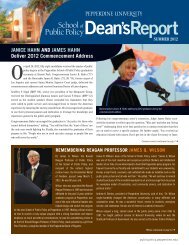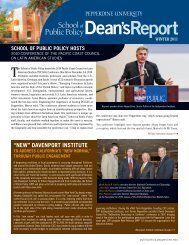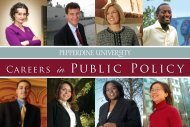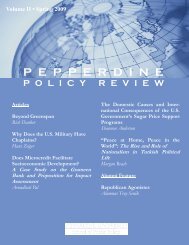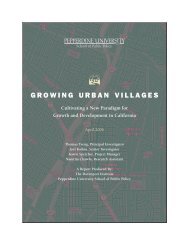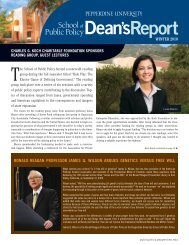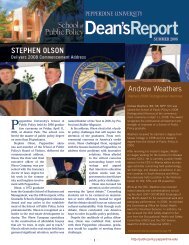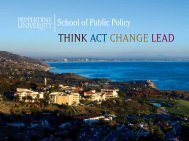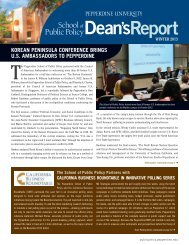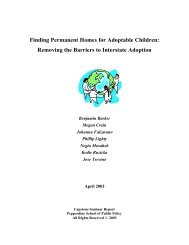Pepperdine University School of Public Policy
Pepperdine University School of Public Policy
Pepperdine University School of Public Policy
You also want an ePaper? Increase the reach of your titles
YUMPU automatically turns print PDFs into web optimized ePapers that Google loves.
Educating Citizens Zeiger<br />
Though education was not included in the Constitution, it was certainly a priority for<br />
the founders; where they differed was on the degree <strong>of</strong> government involvement in education.<br />
Since childhood education remained firmly a matter <strong>of</strong> local and private concern, discussions<br />
among the founders about state and federal educational establishment centered on higher education.<br />
For many early state leaders, higher education was a priority. The North Carolina Constitution<br />
<strong>of</strong> 1776 decreed that “all useful learning shall be duly encouraged and promoted in<br />
one or more universities” (qtd. in Rudolph, The American College 36). Opening its doors less<br />
than two decades later, the <strong>University</strong> <strong>of</strong> North Carolina departed from the traditional liberal<br />
arts curriculum with courses in chemistry, agriculture, mechanic arts, belles lettres, and modern<br />
languages (41-42). Three other states—Georgia, Tennessee, and Vermont—established<br />
state universities by 1800 (36). In addition to founding the Presbyterian-affiliated Dickinson<br />
College, Benjamin Rush drafted his Pennsylvania “Plan for the Establishment <strong>of</strong> <strong>Public</strong><br />
<strong>School</strong>s” to include a single state university, which would draw young scholars from four colleges<br />
to the state capitol to study “law, physic, divinity, the law <strong>of</strong> nature and nations, economy,<br />
etc.” (Rudolph, Essays on Education 4). Temporarily, the state <strong>of</strong> Pennsylvania managed<br />
the <strong>University</strong> <strong>of</strong> Pennsylvania, while New York and New Hampshire respectively held temporary<br />
management <strong>of</strong> Columbia and Dartmouth (Rudolph, The American College 36).<br />
Thomas Jefferson spent much <strong>of</strong> his life building a state university in his home <strong>of</strong> Virginia.<br />
Jefferson began his campaign to improve higher education as a pr<strong>of</strong>essional visitor <strong>of</strong> his<br />
alma mater, the College <strong>of</strong> William and Mary. In 1779, Jefferson initiated administrative reforms<br />
at the college, hoping to enable academic change in conformity to the increasing demands<br />
<strong>of</strong> the growing nation (Pangle, 153). In this he failed. As early as 1800, Jefferson wrote<br />
to Joseph Priestly with his plans for the <strong>University</strong> <strong>of</strong> Virginia, which would be a community <strong>of</strong><br />
full-time pr<strong>of</strong>essors and students highly focused on the natural sciences (H<strong>of</strong>stadter & Smith,<br />
175-176). It was another eighteen years before Jefferson organized a committee on education<br />
at a tavern in Rockfish Gap. The committee devised a plan, which, with some modification, has<br />
become the comprehensive educational system Americans know to this day: local elementary<br />
schools for all children, secondary academies for vocational instruction, and a state university<br />
for the intellectual aristocracy. The university would be secular. Its program <strong>of</strong> study would<br />
include ancient and modern languages, mathematics, physico-mathematics, physics, botany<br />
and zoology, anatomy and medicine, government and political economy and history, municipal<br />
law, and Ideology (rhetoric, ethics, belles lettres, fine arts) (Slosson, 86-88).<br />
For a minority <strong>of</strong> the founders, concern for civic higher education became the basis for<br />
suggesting a national public university. Benjamin Rush first proposed the idea in the January<br />
1787 inaugural issue <strong>of</strong> American Museum magazine. The university would be something like<br />
a graduate school, following upon the completion <strong>of</strong> state-based colleges, emphasizing<br />
“everything connected with government” and “everything connected with defensive and <strong>of</strong>fensive<br />
war” (qtd. in Pangle, 148). In radical distinction from the classically-based European colleges,<br />
“the youth <strong>of</strong> America will be employed in acquiring those branches <strong>of</strong> knowledge which<br />
increase the conveniences <strong>of</strong> life, lessen human misery, improve our country, promote population,<br />
exalt the human understanding, and establish domestic, social, and political happiness”<br />
(148). Fearing that bland ecumenical religion was harmful to genuine devotion, Rush<br />
thought it best to exclude religion from the national university altogether (148-149).<br />
Later that year, the Constitutional Convention took up the idea <strong>of</strong> the university after<br />
Charles Pinckney proposed it. It was not adopted, in part because the federal city already had<br />
authority to establish such an institution, in part because <strong>of</strong> a conviction that universities were<br />
to be state institutions, not federal (Pangle 149). James Madison, who seconded Pinckney’s<br />
resolution, continued to advocate a national university for years, writing as president in 1810<br />
that such an institution would promote patriotism, intellectual enlightenment, republican<br />
13



